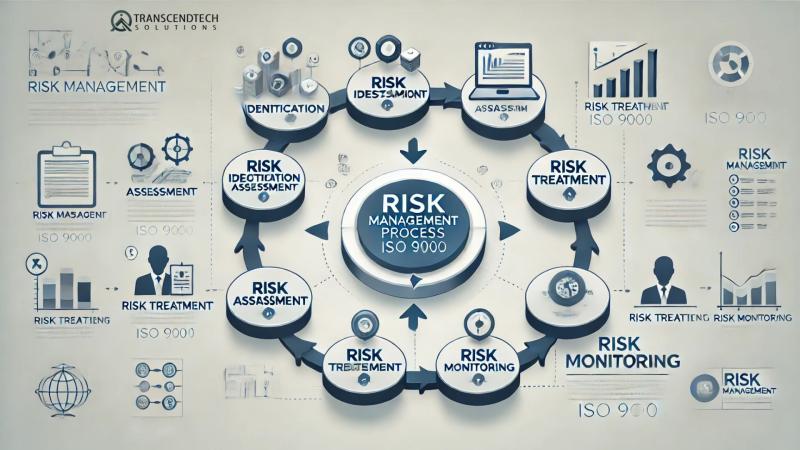How ISO 9001 Helps in Risk Management

Risk management plays a crucial role within the ISO 9001 framework, especially in ensuring a robust Quality Management System (QMS). In ISO 9001:2015, risk-based thinking is emphasized to help organizations identify, assess, and mitigate risks that could affect the quality of their products or services. Implementing effective risk management not only improves operational efficiency but also enhances customer satisfaction by minimizing uncertainties that may disrupt processes.
For organizations in North America, especially in Ontario, ISO 9001 training emphasizes the importance of integrating risk management as a proactive measure to ensure quality consistency. This training helps businesses develop a clear understanding of potential risks, including their causes and consequences, and ensures that the appropriate steps are taken to manage them.
Identifying Risks
One of the first steps in risk management under ISO 9001 is identifying potential risks in processes, products, and services. Identifying these risks involves several approaches, such as brainstorming sessions, process mapping, and interviews with key stakeholders. These methods help in identifying both internal and external risks that could potentially disrupt operations or affect product quality.
ISO 9001 training North America and Ontario provides participants with the tools to identify risks efficiently by fostering a collaborative approach that involves employees at all levels. For instance, frontline workers who are directly involved in processes may have insights into risks that may not be apparent to management. Similarly, involving stakeholders ensures that risks across the supply chain are identified and addressed.
Training programs in Ontario, and broader North America, are designed to help organizations identify risks early and embed risk-thinking into daily operations to ensure a culture of preparedness.
Assessing Risks
After identifying potential risks, the next step is assessing their likelihood and impact. Risk assessment involves both qualitative and quantitative approaches to evaluate how probable it is for a risk to materialize and the potential severity of its consequences. Qualitative approaches often include rating risks on a scale (e.g., low, medium, or high), while quantitative approaches may involve statistical models or financial calculations to determine potential losses.
ISO 9001 training North America, particularly in Ontario, helps organizations understand these risk assessment techniques and their application in different industries. Participants learn to assess the risks based on their complexity, allowing companies to prioritize which risks require immediate attention and which can be monitored over time. This training ensures that businesses can develop risk profiles, guiding them in allocating resources effectively to mitigate critical risks.
Implementing Risk Controls
Once risks are assessed, it is essential to establish control measures to mitigate or eliminate those risks. ISO 9001 requires organizations to implement both corrective actions (to address risks that have already occurred) and preventive measures (to avoid risks before they arise). Control measures can range from process changes to enhanced training programs or the implementation of new technologies to reduce risk exposure.
ISO 9001 training in Ontario and across North America offers practical insights into how to develop and implement effective risk controls. Training focuses on equipping employees with the skills to design and enforce measures that align with ISO 9001 requirements. For example, organizations may implement Standard Operating Procedures (SOPs) or develop contingency plans to address identified risks, thus reducing the likelihood of quality issues arising from unaddressed risks.
Monitoring and Reviewing Risks
Risk management is not a one-time activity—it requires ongoing monitoring and review to ensure that risks remain under control and mitigation measures continue to be effective. ISO 9001 emphasizes the need for continual risk assessments, where organizations track the performance of their control measures and adjust them based on new data or changes in the business environment.
ISO 9001 training in North America, especially in Ontario, stresses the importance of this monitoring process. Through this training, businesses can learn how to set up a review schedule, ensuring that any new or evolving risks are promptly identified and addressed. For example, businesses may conduct periodic internal audits to assess the effectiveness of their risk management practices, adjusting strategies as needed to stay compliant with ISO 9001 standards.
Documenting Risk Management Processes
An essential part of ISO 9001 compliance is the thorough documentation of all risk management activities. Documentation ensures that organizations can demonstrate compliance with ISO 9001 standards and track the history of their risk management efforts. Additionally, documented processes help create a repository of knowledge that can be referenced for future risk management activities.
In ISO 9001 training programs across Ontario and North America, employees are taught the importance of maintaining clear and accurate documentation of all risk management processes, including risk identification, assessments, and control measures. This training helps businesses streamline their documentation processes, ensuring compliance with ISO 9001 while also building a culture of accountability and transparency.
Integrating Risk Management into the QMS
Integrating risk management practices into the broader Quality Management System (QMS) is essential for achieving a cohesive approach to quality and risk control. Risk management should not operate in isolation but rather as part of the larger system that includes all organizational processes. By embedding risk management into the QMS, businesses can ensure that quality objectives and risk mitigation strategies are aligned.
ISO 9001 training in Ontario and across North America emphasizes the need for this integration. Participants learn how to incorporate risk-based thinking into their QMS, ensuring that risks are continually assessed and managed as part of the overall quality strategy. This holistic approach enhances the organization’s ability to adapt to changes, manage risks proactively, and maintain the high-quality standards required for ISO 9001 certification.
In conclusion, ISO 9001 training Ontario and North America provides businesses with the necessary tools to implement robust risk management processes. From identifying and assessing risks to implementing controls and integrating risk management into the QMS, organizations can protect themselves from potential disruptions while ensuring the continuous delivery of high-quality products and services. By investing in ISO 9001 training, companies can not only achieve compliance but also foster a proactive, risk-aware culture that drives long-term success.
Post Your Ad Here
Comments